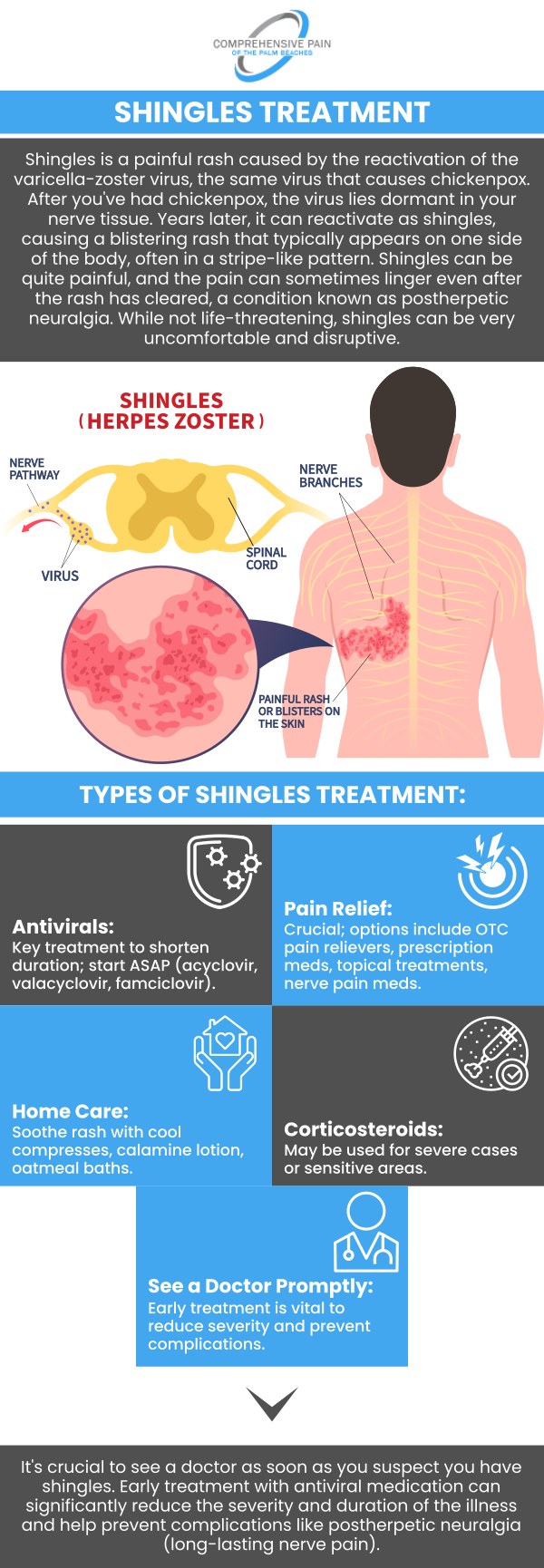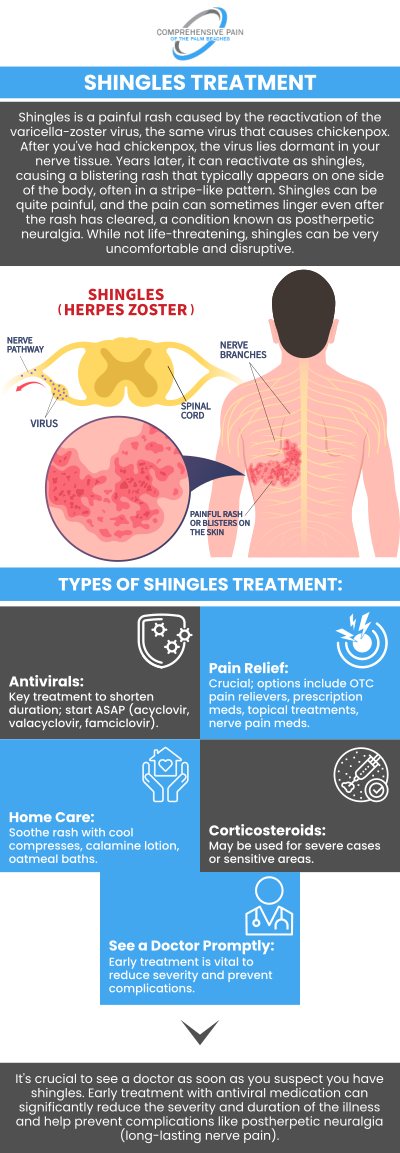Shingles Pain Treatment Specialist in Port St. Lucie, FL
If you’re dealing with shingles pain, Dr. Bart Gatz, M.D., at Comprehensive Pain in Port St. Lucie, FL, offers specialized care to help you find relief. Shingles pain can be severe, but with targeted treatment, we can help reduce discomfort and speed up recovery. Our team works with you to design a personalized treatment plan that helps manage and minimize the effects of shingles pain. For more information, contact us or book an appointment online. We are conveniently located at 481 SW Port St. Lucie Blvd. Port St. Lucie, FL 34953.


Table of Contents:
How long after the rash heals can shingles pain continue?
Does shingles pain always occur in the same area as the rash?
Can stress make shingles pain worse?
How does shingles pain differ from muscle pain?
After the visible rash from shingles heals, some patients continue to experience pain—a condition known as postherpetic neuralgia (PHN). This nerve pain can last for weeks, months, or even years after the skin appears to recover. While many people notice their discomfort gradually decreases within a month or two, about 10 to 18 percent experience lingering pain that may significantly impact daily life.
The risk of developing postherpetic neuralgia increases with age and the severity of the shingles outbreak. Older adults and those with more extensive rashes are especially vulnerable to prolonged nerve pain. When this pain persists for more than three months after the rash has cleared, it is classified as postherpetic neuralgia.
Our team specializes in diagnosing and managing chronic pain conditions. If you are struggling with persistent pain after shingles, seeking timely, expert care is essential. We offer a range of advanced treatment options to help manage your symptoms, reduce discomfort, and improve your quality of life.
One of the most significant and often distressing symptoms of shingles is pain, which is usually accompanied by a distinctive rash. At Comprehensive Pain, we frequently see patients who struggle with this type of nerve-related pain, both during and after the shingles outbreak.
The pain associated with shingles usually occurs in the same area as the rash. This is because the virus reactivates in a specific nerve root, causing inflammation of both the nerve and the skin it supplies. As a result, patients often describe burning, stabbing, or throbbing pain that follows a band-like pattern on one side of the body. This pain pattern is a hallmark of shingles and is something our pain specialists are highly experienced in diagnosing and managing.
Sometimes, the pain can start before the rash appears—this is called prodromal pain. This early pain can make diagnosis challenging, especially if other symptoms are mild or absent. In rare cases, some individuals may have nerve pain without ever developing a visible rash, a condition known as “zoster sine herpete.” After the rash has healed, some patients continue to experience persistent nerve pain, known as postherpetic neuralgia, which can significantly impact quality of life.
We understand how debilitating shingles pain—and especially postherpetic neuralgia—can be. Our team specializes in advanced pain management strategies tailored to your unique situation, including medications, nerve blocks, and other interventional therapies aimed at relieving nerve pain and improving your daily function.
When you’re under significant stress, your immune system becomes less effective at keeping the virus in check. This not only increases your risk of developing shingles, but it can also make the pain more severe. Shingles pain is often described as burning, stabbing, or throbbing, and emotional or physical stress can amplify these sensations. Stress hormones like cortisol and adrenaline can heighten your body’s sensitivity to nerve pain, making symptoms even harder to manage.
At Comprehensive Pain, we take a holistic approach to managing your pain. We recognize that pain is not just a physical sensation but also an emotional experience. That’s why we offer a range of therapies to address both the physical and psychological aspects of shingles pain, including:
● Personalized medication management to control nerve pain and inflammation
● Interventional procedures to target severe or persistent pain
● Stress reduction techniques, such as relaxation training and mindfulness
● Supportive counseling and resources to help you cope with the emotional impact of shingles
If you’re struggling with shingles pain, don’t hesitate to reach out to our team. We’ll work with you to develop a comprehensive, individualized treatment plan that manages your symptoms and improves your quality of life.
At Comprehensive Pain, we understand that not all pain is the same, and an accurate diagnosis is essential for effective treatment. Two common but very different types of pain we see in our patients are shingles pain and muscle pain. Understanding their differences is the first step toward relief and recovery.
Shingles pain, also known as herpes zoster pain, is caused by the reactivation of the varicella-zoster virus (the same virus that causes chickenpox). Patients with shingles often describe their pain as burning, stabbing, or shooting, usually affecting one side of the body in a band-like pattern. This pain is often accompanied by tingling, numbness, sensitivity to touch, and a blistering rash. Even after the rash subsides, some patients develop postherpetic neuralgia—a chronic nerve pain that can be especially challenging to treat without expert care.
Muscle pain (myalgia), on the other hand, typically results from overuse, injury, or tension in the muscles. This type of pain is more likely to feel sore, aching, or stiff, and it often worsens with movement or pressure. Unlike shingles, muscle pain is rarely associated with skin changes like rashes or blisters.
At Comprehensive Pain, our team specializes in identifying the root cause of your pain—whether it’s neuropathic pain from nerve involvement, as seen in shingles, or musculoskeletal pain from muscle injury. We use advanced diagnostic tools and a multidisciplinary approach to create personalized treatment plans, which may include medications, nerve blocks, physical therapy, and other interventions for long-lasting relief.
If you are struggling with persistent, severe, or unusual pain—especially if you notice a rash, skin changes, or nerve-related symptoms—don’t wait to seek help. Early and accurate diagnosis can make a significant difference in your outcome. For more information, contact us or book an appointment online. We are conveniently located at 481 SW Port St. Lucie Blvd. Port St. Lucie, FL 34953. We serve patients from Port St. Lucie FL, Stuart FL, Palm City FL, Greenacres FL, Palm Springs FL, Boynton Beach FL, and surrounding areas.
Check Out Our 5 Star Reviews



Additional Services You May Need
▸ Knee Pain
▸ Arthritis
▸ Back Pain
▸ Neck Pain
▸ Neuropathy
▸ Headaches
▸ Nerve Damage
▸ Fibromyalgia
▸ Chronic Pain
▸ Osteoporosis
▸ Muscle Injuries
▸ Pinched Nerve
▸ Diabetes Pain
▸ Herniated Disc
▸ Pain After Surgery
▸ Mere Conditions


